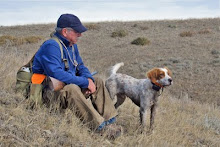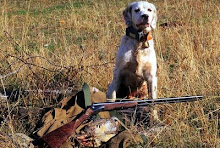Two recent additions to our library have been Earl Crangle’s Pointing Dogs: Their Training and Handling and Jack Sharkey’s Winning Ways: Training Your Pointing Breed Dog for Hunting and Competition. The first came on Mike’s recommendation (and he has posted on a segment of this already) and Earl Crangle makes Jack Sharkey look like a relative newcomer in the world of pointing dog training and handling. I had seen Jack Sharkey’s book before but hadn’t paid enough attention to it. Where Earl Crangle comes from a HOF trainer’s lineage, Sharkey is perhaps remarkable for having trained and largely handled his own dogs – and in the 17 years of doing so, having produced the AKC’s first and only quintuple champion. I should also mention that Jack’s dogs are vizslas – and that the quintuple champion is Legacy De’Chartay (pictured here on the right).
Handling and Jack Sharkey’s Winning Ways: Training Your Pointing Breed Dog for Hunting and Competition. The first came on Mike’s recommendation (and he has posted on a segment of this already) and Earl Crangle makes Jack Sharkey look like a relative newcomer in the world of pointing dog training and handling. I had seen Jack Sharkey’s book before but hadn’t paid enough attention to it. Where Earl Crangle comes from a HOF trainer’s lineage, Sharkey is perhaps remarkable for having trained and largely handled his own dogs – and in the 17 years of doing so, having produced the AKC’s first and only quintuple champion. I should also mention that Jack’s dogs are vizslas – and that the quintuple champion is Legacy De’Chartay (pictured here on the right).
It might actually be a more enjoyable read for everyone if I compare the two books rather than review each one individually. Both books have the prerequisite puppy section that emphasizes the careful selection of breed (although for Crangle there are really only two) and subsequently parents, Crangle makes the observation that even after 30yrs experience, choosing the best prospect from a litter of 12wk-old puppies is “pure guesswork at this age.” Sharkey’s book is interesting because both his first two vizslas, Hodag’s Hunter (himself a HOF inductee) and Legacy, were the runts of their respective litters. Later in his book, and while I have limited faith in the ‘wing on a string’ with very young dogs, Sharkey also intimates that while many of his dogs were pointing bird-wings at very young ages, his quintuple champion didn’t start pointing till almost 21months old! While parents’ performance is generally the best predictor of progeny performance, both of these facts serve as useful reminders that great dogs are sometimes found where we least expect them, that dogs develop at different speeds (and so shouldn’t be written off too early), and that love and a clear training plan will get most folk a very long way.
One of the things that shines through both books is that basic obedience and  yard-work carries forward into bird-work. Crangle’s book has a good section on yard-work with a list of the commands he expects a dog to be proficient at; Sharkey’s are interspersed in a couple of chapters. I wish more folks had a better grasp of this before they started even relatively rudimentary Junior Hunting tests – they and their dogs would have more fun. This isn’t to say that I’ve seen a lot of badly behaved dogs, but it is to say that I’ve encountered some owners anxious about how to train for a hunt test when they have limited opportunities to get on birds and others who simply decide that the dog will now handle the new scenario of a bird-field by intuition (and then wonder why their dog gets high on bird-scent and stops responding to them after they’ve been essentially silent for 15mins). ‘Whoa’ is not a magic word, nor is its intended outcome a new one for most dogs with basic obedience training – and for that matter, if an owner decides to replace ‘whoa’ with ‘stop’ to keep it simpler for the human part of the equation, it will still be just as effective and fun for the dog.
yard-work carries forward into bird-work. Crangle’s book has a good section on yard-work with a list of the commands he expects a dog to be proficient at; Sharkey’s are interspersed in a couple of chapters. I wish more folks had a better grasp of this before they started even relatively rudimentary Junior Hunting tests – they and their dogs would have more fun. This isn’t to say that I’ve seen a lot of badly behaved dogs, but it is to say that I’ve encountered some owners anxious about how to train for a hunt test when they have limited opportunities to get on birds and others who simply decide that the dog will now handle the new scenario of a bird-field by intuition (and then wonder why their dog gets high on bird-scent and stops responding to them after they’ve been essentially silent for 15mins). ‘Whoa’ is not a magic word, nor is its intended outcome a new one for most dogs with basic obedience training – and for that matter, if an owner decides to replace ‘whoa’ with ‘stop’ to keep it simpler for the human part of the equation, it will still be just as effective and fun for the dog.
For me, as I contemplate trialing for the first time, two things really separate these books. Earl Crangle’s has an air of the memoir to it, certainly not of him, but to give an example his last section in the book is titled ‘Some Dogs I Have Known.’ Reading Earl’s book is in some ways a look back to a ‘golden age’ of trialing when there were more opportunities for wild bird trials and more field trial grounds capable of sustaining such bird populations. Earl has had a great life with dogs – and that love and respect for them shines through. By contrast, Jack Sharkey’s book has a few more practical tips in particular for novice field-trial handlers both in terms of handling and campaigning their dogs. (Jack also offers a few insights on Hunt Tests, some of which are now unfortunately no longer correct due to the AKC rule changes in January 2008; he also has some small sections on obedience, agility, tracking and conformation competition.)
If I was looking for a single book to guide me through training, I would still recommend Dave Walker’s The Bird-Dog Training Manual first and foremost – if only because both Crangle and Sharkey walk you quickly through the spirit of a number of training ideas, but Walker has more pictures and more of a step-by-step approach. For me in my training and handling career right now, I’d probably recommend Jack Sharkey’s Winning Ways first – but for those looking for a sense of where trialing has come from and wisdom gained from decades of working with dogs Earl Crangle's Pointing Dogs is a great addition.








2 comments:
What a great resource for the bird dog lover! I just found your blog, congratulations! I've added it to my roll over at www.hunteatlive.blogspot.com
Post a Comment